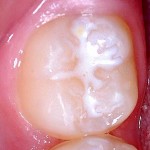
Reviews have clearly demonstrated the effectiveness of pit and fissure sealants in preventing caries, but they have highlighted a need to clarify the relative effectiveness of different sealant materials, such as fluoride-containing or non-fluoride resin-based sealants.
The primary aim of this trial was to assess the effectiveness of dental sealants in preventing the occurrence of ICDAS 3–6 carious lesions within a 2-years. Secondary aims were to assess the effectiveness of sealants, with and without fluoride, their retention rates, and the caries risk factors related to their outcomes.
Methods
This was a multi-centre split-mouth study conducted in France. Patients aged between 5-15yrs with at least one pair of contralateral permanent molars, either caries-free (ICDAS 0) or with non- cavitated carious lesions (ICDAS 1–2) were included. A randomisation process initial tooth and sealant type was used. Baseline examinations, including a visual inspection using the ICDAS criteria and an assessment of increased caries risk (ICR) were conducted by a single dentist at each centre. Patients were considered to be at high ICR when they presented at least one ICDAS 3–6 lesion.
Following prophylaxis teeth were isolated with cotton rolls or a rubber dam according to the stage of eruption. The occlusal surface was dried and etched with 37% phosphoric acid gel for 20 s, followed by thorough rinsing for 20s using an oil-free air-water syringe followed by the placement of the sealant (with or without fluoride). The primary outcome was the presence of an ICDAS 3–6 lesion on sealed tooth during the 2-year follow- up. The secondary outcome was sealant retention, classified as total, partial (did not cover all occlusal pits and fissures) or not (zero retention). A blinded examiner (1 at each centre) reviewed patients at 6, 12, 18 and 24 months. A multi-variable Cox hazard regression model was used to assess the effectiveness of the sealants.
Results
- 400 families out of 433 meeting the eligibility criteria participated.
- 137 children had one tooth pair included, 263 two tooth pairs.
- 263 children (73%) completed the 2-yr follow up.
- 70.4% of permanent molars had total retention of sealant at 24 months.
- Sealed molars had a lower risk of ICDAS 3–6 lesions than the non-sealed molars; Hazard ratio [HR] = 0.16 (95% CI: 0.14– 0.19) p < 0.0001) during the 2-year follow-up.
- The effect of the sealant was similar regardless of whether it contained fluorides or not
- HR (fluoride) = 0.15 (95% CI: 0.12– 0.19) p < 0.0001.
- HR (n0-fluoride) = 0.18 (95% (CI: 0.15–0.21) p < 0.0001.
Conclusions
The authors concluded: –
It is important to seal the permanent molars of all high ICR children if ICDAS 3–6 lesions are present on other teeth. This allows the prevention of ICDAS 3–6 lesions. Moreover, the preventive effect is less strong for permanent molars with deep fissure morphology or with non- cavitated carious lesion (ICDAS 1–2). Any benefits of resin-based sealant with fluoride in preventing caries remains to be confirmed.
Comments
The recently updated Cochrane review (Dental Elf -31st Jul 2017) provided moderate quality evidence that sealants were effective in reducing caries. The Cochrane data suggests that in a child population where you might expect decay to occur in 40% of permanent molar teeth then you could expect that the application of sealants to reduce this to just 6% in children aged 5-10 years. This well conducted study has similar findings to the review in terms of caries prevention but found little difference between the different types of sealant. Although there was a suggestion that following loss of sealant loss there was a tendency for less caries progression when a sealant containing fluoride was used. However, as the authors indicate further studies are needed to clarify whether there is any additional benefit from the use of fluoride containing sealants.
Links
Primary Paper
Muller-Bolla M, Courson F, Lupi-Pégurier L, Tardieu C, Mohit S, Staccini P, Velly AM. Effectiveness of Resin-Based Sealants with and without Fluoride Placed in a High Caries Risk Population: Multicentric 2-Year Randomized Clinical Trial. Caries Res. 2018 Mar 1;52(4):312-322. doi:10.1159/000486426. [Epub ahead of print] PubMed PMID: 29495020.
Other references
Dental Elf -31st Jul 2017
Fissure sealants effective in preventing caries in children and adolescents
Hazard Ratios- Students 4 Best Evidence

[…] post Fissure sealants: are those with fluoride more effective in preventing caries? appeared first on National Elf […]